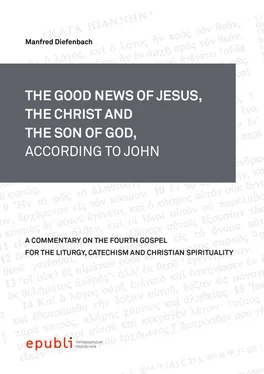2.2.10 Jesus’ Distant Healing of the Royal Official’s Son from Capernaum in Cana (vv. 46–54 352)
- The Setting (v. 46a–c)
Who:Jesus, the royal official (from Capernaum), his son (in Capernaum)
Where:“from Judea to Galilee” (vv. 43, 45, 47b, 54b), Cana (v. 46a) – Capernaum (v. 46d)
When:during Jesus’ public mission in Galilee – “ yesterday at the 7 th hour ” (v. 52d)
Across-reference with the first sign at “ Cana ” in John 2:1–11 and verse 54 353“ where ” Jesus “ had made water wine ” (in Greek “ tò húdor oῖnon ”in v. 46b and 2:9) introduces a new scenic-dialogical story of the “ royal official 354 ’s son ” (v. 46c, d 1) from “ Capernaum ” 355(v. 46d 2and 2:12; 6:17, 24, 59). Because of his Galilean settlement in Capernaum he was probably a royal official of the King Herod Antipas 356(4 B.C.–39 A.D.) (cf. Luke 8:3), the tetrarch of the district Galilee and Perea.
- The Diagnosis (vv. 46d, 47e)
The royal official came from “ Capernaum ” (v. 46d) to Jesus at “ Cana ” (v. 46a) because of his “( ) sick 357( son )” (v. 46d). The distance of both settlements is 26 kilometres 358– a one-day trip 359(cf. v. 52d).
- The Double Request by the Royal Official (vv. 47–49)
v. 47:The “ father ” (v. 53a) of the sick “ boy / child ” (vv. 49c, 51d) “ heard ” from hearsay that “ Jesus had come from Judea to Galilee ” (cf. vv. 3, 47b, 54b). Therefore he “ came to Him ” – note again the verbum compositum “ap-érchomaɩ” in verses 3b, 8a, 28b, 47c – and “ requested / begged / asked ” Him as an indirect questioning:
Please “come down” 360from “ Cana ” about 300 metres above sea-level to “ Capernaum ” near the northwest corner of the “Sea of Galilee/Tiberias” “ and
heal ” 361my “ son ” who is “ close to die” (cf. v. 49b, c).
v. 48:“ Jesus ” said a critical word regarding of the faith in wonders 362(cf. John 2:18, 23–25 and Mark 8:11; Matthew 12:38; 16:1; Luke 11:16, 29; 23:8; 1 Corinthians 1:22) to the royal official: “ Unless you (see ) signs and wonders 363( ),
you / do / not believe .”
v. 49:As in verse 47, the “ royal official ” (intensively) begged Him again:
“ Lord ” (vv. 11b, 15b, 19b),
“come down” (vv. 47d, 51a)
“ before ( my ) boy /child ( )” (v. 51d) “dies” (cf. v. 47e).
- Jesus’ Distant Healing with His Word (v. 50a–b)
After His request, “ Jesus ” gave him the order – note the imperative:
“Go, ( your ) son ( ) lives ” or “/ is / alive ” (cf. v. 51d and Mark 7:29) – note the opposite verb “die” in verses 47e, 49c.
- Declaration of the Healing (vv. 50c–53d)
v. 50c:Because of his “ believing ”/faith 364in Jesus’ “ word ” (cf. Romans 10:17) his son was cured. So the royal official is a “model of faith” according to the Fourth Gospel (cf. Matthew 8:10; 15:28; Luke 7:9).
v. 51:During his one-day way home from Cana to Capernaum (cf. v. 46a, d) the royal official’s “ servants ” 365went to “ meet ” 366him, saying with the same words of Jesus’ promise (cf. v. 50b) in the form of an indirect speech: Your “ boy / child 367 was living / alive ”.
v. 52:The royal official questioned his servants the “ hour when ” his son’s “ fever ” 368(cf. Mark 1:31; Matthew 8:15; Luke 4:38–39) started to “ get better ”. Their answer was: “ Yesterday 369 at the seventh hour ” (= 1 p.m.) –
v. 53:just at this moment “ when (Jesus ) said / to / him ( ): “( Your ) son ( ) lives ”/“/ is / alive ” (vv. 50b, 51d, 53d). The royal official “ realized ( )” that. At home of the faithful royal official at Capernaum, “ the father ” (cf. Mark 7:25; Matthew 15:22) found his son well. According to the Hebrew Bible, “God was impressed by the faith of Abraham to save other people. So, in the New Testament, Jesus is impressed by the faith of one man to exercise his power in favour of someone else” 370, because God, the Creator, and also His Son Jesus are there for everybody else. Jesus, the healer and the Savour, gave life to the royal official’s son (cf. vv. 50b, 51d, 53d).
- Reaction of the Royal Official (v. 53e)
Therefore the royal official as the “pater familias” 371and his “ whole household ” – that means his wife and his children as well as His (male and female) servants – let themselves be baptized and become a “familia dei” 372(cf., for example, Acts 10:2; 11:14; 16:15, 31–34; 18:8; 1 Corinthians 1:16) who follow/ed God’s criteria and Jesus’ steps in word and deed/action – then and now.
- The Comment by the Evangelist (v. 54)
The Fourth Evangelist concludes the “story” of Jesus’ distant healing of the royal official’s son” (cf. vv. 46–53) in Cana (cf. John 2:1, 11) as “the second sign” (cf. Exodus 4:8) – note the counting of the “first sign” in 2:11 and the “second sign” in verse 54a – of seven signs (cf. 2:1–11; 4:46–53; 5:1–18; 6:1–15, 16–21/24; 9:1–7/42;11:1–45). The Fourth Evangelist also concludes the narrative cycle of Jesus’ public mission “from Cana to Cana” (cf. 2:1–4:54 373) in the districts “Galilee” (vv. 3b, 47b, 54b) and “Judea” (vv. 3a, 47b, 54b).
Chapter 5
2.3 Jesus and the Jewish Feasts (5:1–10:42 374)
After the scenic-dialogical part “From Cana to Cana” (cf. 2:1–4:54), the Fourth Evangelist structured a “new part” of narrative stories and dialogues as a scenic-dialogical scene (cf. 5:1–10:42) during Jesus’ stays in Jerusalem because of the Jewish festivals (in Greek “ heorté ” in 5:1; 6:4; 7:2, 8, 10–11, 14, 37). With Chapter 11 Jesus starts His last days/Passion, Death and Resurrection around (cf. 11:1–12:11) and in Jerusalem (cf. v. 12–20:29).
Microstructure of John 5
Jesus’ third healing of a lame man on the Sabbath (cf. vv. 1–9 – note also John 9:1–7/41; Mark 3:1–6/Matthew 12:9–14/Luke 6:6–11; 13:10–17; 14:1–6) is the reason for a controversial discussion during the hearing (cf. vv. 10–18 and John 1:19–28; 9:8–34; 18:13–14, 19–24) of the cured man by “the Jews” (cf. vv. 10–13, 15) which becomes a (Christological) “monologue” 375(cf. vv. 19–47 – in two parts in vv. 19–30, 31–47) as His legitimation 376(cf. v. 17). The first part of His speech in verses 19–30 has the topic of His relationship with God the Father that Jesus “does nothing of himself, but the Father has given all things to him.” The second part in verses 31–47 emphasizes with “five arguments” that “God (Another) has testified on Jesus’ behalf” (cf. vv. 36b–38, 43); “so also” John the Baptist (cf. v. 36a), “and the works that Jesus is doing” (cf. vv. 36b–d), “and Scripture” (cf. vv. 39, 47), “and finally Moses who wrote about Jesus” 377(cf. vv. 45–46).
Читать дальше












